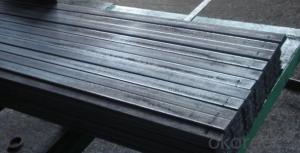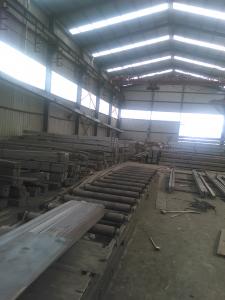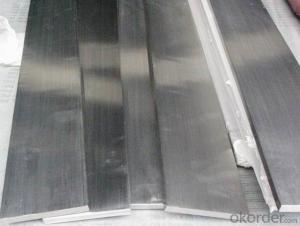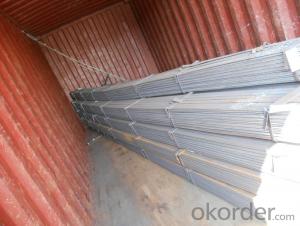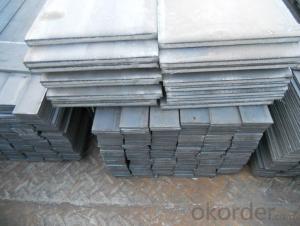Hot rolled steel flat bar in Grade Q235 for construction
- Loading Port:
- Tianjin
- Payment Terms:
- TT OR LC
- Min Order Qty:
- 10000 m.t.
- Supply Capability:
- 100000 m.t./month
OKorder Service Pledge
OKorder Financial Service
You Might Also Like
Product Description:
OKorder is offering hot rolled steel flat bar in Grade Q235 for construction at great prices with worldwide shipping. Our supplier is a world-class manufacturer of steel, with our products utilized the world over. OKorder annually supplies products to European, North American and Asian markets. We provide quotations within 24 hours of receiving an inquiry and guarantee competitive prices.
Product Applications:
Hot rolled steel flat bar are ideal for structural applications and are widely used in the construction of buildings and bridges, and the manufacturing, petrochemical, and transportation industries.
Product Advantages:
OKorder's Steel Flat Bar for construction are durable, strong, and resist corrosion.
Main Product Features:
· Premium quality
· Prompt delivery & seaworthy packing (30 days after receiving deposit)
· Corrosion resistance
· Can be recycled and reused
· Mill test certification
· Professional Service
· Competitive pricing
Product Specifications:
Manufacture: Hot rolled
Grade: Q195 – 235
Certificates: ISO, SGS, BV, CIQ
Length: 6m – 12m, as per customer request
Packaging: Export packing, nude packing, bundled
Chinese Standard (H*W*T) | Weight (Kg/m) | 6m (pcs/ton) | Light I (H*W*T) | Weight (Kg/m) | 6m (pcs/ton) | Light II (H*W*T) | Weight (Kg/m) | 6M |
100*68*4.5 | 11.261 | 14.8 | 100*66*4.3 | 10.13 | 16.4 | 100*64*4 | 8.45 | 19.7 |
120*74*5.0 | 13.987 | 11.9 | 120*72*4.8 | 12.59 | 13.2 | 120*70*4.5 | 10.49 | 15.8 |
140*80*5.5 | 16.89 | 9.8 | 140*78*5.3 | 15.2 | 10.9 | 140*76*5 | 12.67 | 13.1 |
160*88*6 | 20.513 | 8.1 | 160*86*5.8 | 18.46 | 9 | 160*84*5.5 | 15.38 | 10.8 |
180*94*6.5 | 24.143 | 6.9 | 180*92*6.3 | 21.73 | 7.6 | 180*90*6 | 18.11 | 9.2 |
200*100*7 | 27.929 | 5.9 | 200*98*6.8 | 25.14 | 6.6 | 200*96*6.5 | 20.95 | 7.9 |
220*110*7.5 | 33.07 | 5 | 220*108*7.3 | 29.76 | 5.6 | 220*106*7 | 24.8 | 6.7 |
250*116*8 | 38.105 | 4.3 | 250*114*7.8 | 34.29 | 4.8 | 250*112*7.5 | 28.58 | 5.8 |
280*122*8.5 | 43.492 | 3.8 | 280*120*8.2 | 39.14 | 4.2 | 280*120*8 | 36.97 | 4.5 |
300*126*9 | 48.084 | 3.4 | 300*124*9.2 | 43.28 | 3.8 | 300*124*8.5 | 40.87 | 4 |
320*130*9.5 | 52.717 | 3.1 | 320*127*9.2 | 48.5 | 3.4 | |||
360*136*10 | 60.037 | 2.7 | 360*132*9.5 | 55.23 | 3 |
FAQ
Q1: What makes stainless steel stainless?
A1: Stainless steel must contain at least 10.5 % chromium. It is this element that reacts with the oxygen in the air to form a complex chrome-oxide surface layer that is invisible but strong enough to prevent further oxygen from "staining" (rusting) the surface. Higher levels of chromium and the addition of other alloying elements such as nickel and molybdenum enhance this surface layer and improve the corrosion resistance of the stainless material.
Q2: Can stainless steel rust?
A2: Stainless does not "rust" as you think of regular steel rusting with a red oxide on the surface that flakes off. If you see red rust it is probably due to some iron particles that have contaminated the surface of the stainless steel and it is these iron particles that are rusting. Look at the source of the rusting and see if you can remove it from the surface.
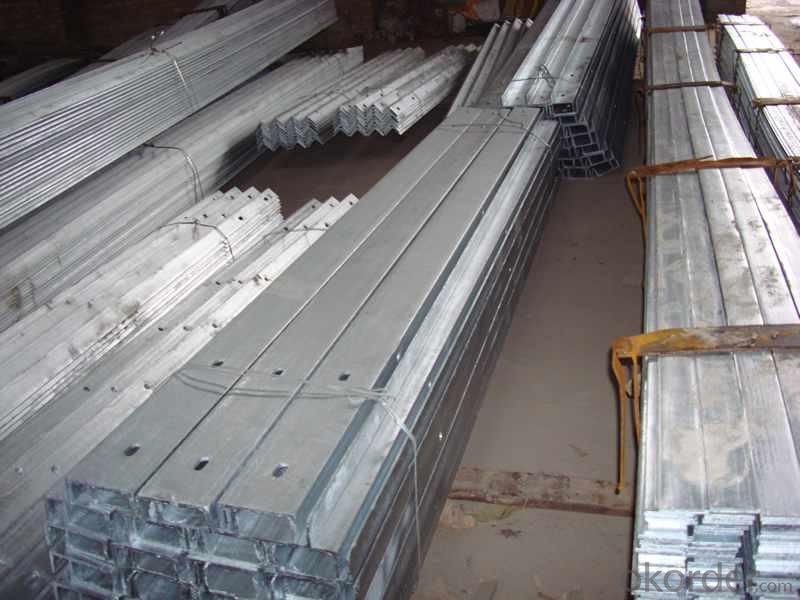


- Q:Are steel flat bars resistant to impact or vibration?
- Yes, steel flat bars are generally resistant to both impact and vibration due to their strong and rigid nature. The high tensile strength of steel allows it to withstand sudden forces and impacts without deforming or breaking. Additionally, steel's inherent damping properties help absorb vibrations, making it suitable for applications where impact and vibration resistance are required.
- Q:Can steel flat bars be used for making heat exchangers or cooling systems?
- Yes, steel flat bars can be used for making heat exchangers or cooling systems. Steel is commonly used in the construction of heat exchangers due to its high thermal conductivity, strength, and corrosion resistance. The flat bars can be formed and welded together to create the required shapes and structures for efficient heat transfer and cooling processes.
- Q:Are steel flat bars suitable for making furniture?
- Yes, steel flat bars are suitable for making furniture. They are strong, durable, and can be shaped into various designs.
- Q:What is the typical width tolerance for steel flat bars?
- The typical width tolerance for steel flat bars can vary depending on the specific grade and manufacturing process, but it is generally within a range of +/- 0.005 to 0.03 inches.
- Q:What is the difference between flat steel and steel sheet material?
- It is a kind of flat steel, flat steel plate is mainly used for general structure, construction, general machinery parts; and the steel plate is including carbon steel, alloy steel, high performance steel structure, this kind of material is.
- Q:Are steel flat bars suitable for welding projects?
- Yes, steel flat bars are suitable for welding projects. They have excellent weldability and can be easily joined together using various welding methods such as arc welding, MIG welding, or TIG welding. The flat shape of the bars also provides stability and ease of handling during the welding process.
- Q:Can steel flat bars be used in the construction of bridges?
- Certainly! Steel flat bars are capable of being utilized in the construction of bridges. The utilization of steel in bridge construction is prevalent due to its superior strength, durability, and capacity to endure substantial loads. In bridge construction, steel flat bars frequently serve as structural elements, particularly for beams, girders, and piers. They offer exceptional support and stability, enabling bridges to cover vast distances and accommodate heavy traffic loads. Moreover, steel flat bars can be tailored and manufactured to specific dimensions and configurations, rendering them versatile and suitable for diverse bridge designs. In essence, steel flat bars are an indispensable constituent in bridge construction, contributing to the fortitude, safety, and longevity of these structures.
- Q:How do I determine the strength of a steel flat bar?
- To determine the strength of a steel flat bar, you need to consider its grade, which indicates the alloy composition and mechanical properties of the steel. The grade is usually marked on the bar or can be obtained from the manufacturer's specifications. Additionally, you can refer to industry standards or consult engineering handbooks that provide information on the strength and properties of various steel grades.
- Q:How do steel flat bars perform in terms of fatigue resistance?
- Steel flat bars generally have good fatigue resistance due to their high strength and stiffness properties. They can withstand repeated loading and stress cycles without experiencing significant structural damage or failure. However, the specific fatigue performance of steel flat bars may vary depending on factors such as the steel grade, manufacturing process, surface finish, and design considerations.
- Q:Can steel flat bars be heat-treated?
- Indeed, it is possible to subject steel flat bars to heat treatment. By undergoing controlled heating and cooling, this process effectively transforms the physical and at times chemical attributes of the steel. The objective behind heat treatment varies, encompassing the augmentation of hardness, the enhancement of strength, the fortification of toughness, and the customization of other mechanical properties to meet specific application requirements. Depending on the desired results, various heat treatment techniques such as annealing, normalizing, quenching, and tempering may be employed on steel flat bars.
1. Manufacturer Overview |
|
|---|---|
| Location | |
| Year Established | |
| Annual Output Value | |
| Main Markets | |
| Company Certifications | |
2. Manufacturer Certificates |
|
|---|---|
| a) Certification Name | |
| Range | |
| Reference | |
| Validity Period | |
3. Manufacturer Capability |
|
|---|---|
| a)Trade Capacity | |
| Nearest Port | |
| Export Percentage | |
| No.of Employees in Trade Department | |
| Language Spoken: | |
| b)Factory Information | |
| Factory Size: | |
| No. of Production Lines | |
| Contract Manufacturing | |
| Product Price Range | |
Send your message to us
Hot rolled steel flat bar in Grade Q235 for construction
- Loading Port:
- Tianjin
- Payment Terms:
- TT OR LC
- Min Order Qty:
- 10000 m.t.
- Supply Capability:
- 100000 m.t./month
OKorder Service Pledge
OKorder Financial Service
Similar products
New products
Hot products
Related keywords
